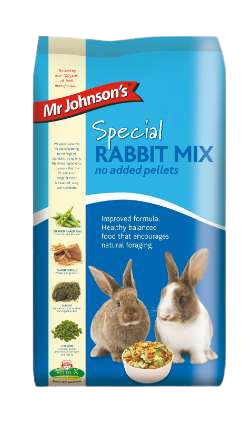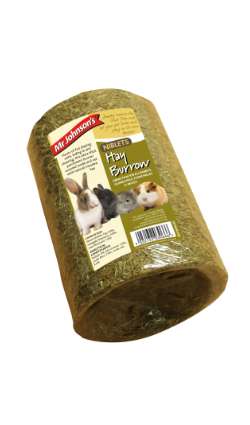 Feeding the correct food to your rabbit is essential for maintaining good health. Fibrous feed is required for normal digestive function and for dental wear. In the wild a rabbits diet is high in fibre so it’s essential the diet you feed them supplies them with this essential fibre.
Feeding the correct food to your rabbit is essential for maintaining good health. Fibrous feed is required for normal digestive function and for dental wear. In the wild a rabbits diet is high in fibre so it’s essential the diet you feed them supplies them with this essential fibre.
Rabbits, if overfed, can sometimes selectively feed and may leave their less favourite ingredient in the bowl until last. To help overcome selective feeding your rabbit should be fed twice a day, dividing their daily requirements into two meals and feeding morning and evening and only refilling the bowl once empty.
What to feed your rabbit?
Rabbits require diets that are high in fibre and their daily diet should be made up of 85-90% good quality hay/forage along with a carefuly measured portion of commercial rabbit food as reccomended on the pack. There are various types of rabbit foods on the market, two of the most popular types are:
Coarse mixes are a blend of cereals, extrusions, vegetables &/or fruit that supply your rabbit with a mix that’s balanced & nutritious and also encourages their natural foraging instinct with a variety of different textures in the mix like rabbits would eat in the wild. Mr Johnson’s Supreme Rabbit Mix, Supreme Junior & Dwarf Rabbit Mix, Supreme Tropical Fruit Rabbit Mix, Special Rabbit and Choice Rabbit are all coarse mixes.
Extruded food – a single tasty nugget that’s easy to digest, contains all the goodness in every mouthful thus preventing the potential to selectively feed. Mr Johnson’s Advance Rabbit Food & Junior & Dwarf Rabbit Food are both single component extruded foods.
Your rabbit’s diet should never be changed suddenly. Abrupt changes in your rabbit’s diet could trigger digestive upsets, especially in baby rabbits or rabbits that are stressed (for example if they have moved to a new home). If you want to change your rabbit’s diet, it is recommended that this change takes place gradually over a 10 day period. This can be done by mixing small quantities of the new food in with their existing food, while reducing their existing food proportionally until the food is fully changed over.
Why is hay so important for a rabbits health?
Hay might look boring to humans but for rabbits it should be their main dish of the day, and should make up 85-90% of their daily diet. Good quality hay helps keep rabbit’s healthy, especially their gut and teeth.
Hay keeps the gut moving –Hay is made up of long fibre that help the muscles of a rabbit’s gut stay strong and function correctly. A rabbit’s complex digestive system means they need to constantly snack on hay throughout the day to keep things moving inside, and help prevent blockages. Blockages can often be fatal. If a rabbit doesn’t eat enough hay then their intestinal functions can slow down and cause a condition called GI Stasis/ Gastrointestinal Stasis also referred to as ‘the silent killer’ is the condition when food stops moving through the gut as quickly as it should. This can result in the gut contents becoming compact into a hard, immobile mass (impacted gut), dehydration and fermentation can occur, causing a significant gas build up and as a result pain for the rabbit or even death. The first signs of GI stasis may be the rabbit suddenly goes off their food or a reduction in the amount of faeces being produced. If you observe any of these symptoms please consult your vet immediately.
Chewing hay grinds their ever-growing teeth down to a safe level –The teeth of rabbits continuously grow, at a rate of about 3mm a week therefore its vital that they fed the correct diet in order to help kept their teeth worn down and avoid any health issues associated with overgrown teeth. Good quality hay (or grass) is the best way to ensure teeth are kept ground down because the side to side grinding action required for eating hay ensures teeth are kept to the correct length. Uneven wear or overgrown teeth can also result in sharp spurs developing on the sides of the cheek teeth. These spurs cause painful damage to the soft tissues of the cheeks and the tongue each time the rabbits move their mouths.
Signs that a rabbit is suffering from dental problems can be runny eyes, jaw swellings, facial abscesses, difficulty eating, a reduction in the amount of faeces being produced and a reduced interest in eating hay. If you observe any of these symptoms please consult your vet immediately.
How much hay should rabbits eat and how often? Rabbits need unlimited access to fresh clean good quality hay 24 hours a day. No one likes dirty, stale food so yesterday’s hay can be used in their bedding area or thrown away and a nice fresh pile of hay should be available daily. Remember to check their hay during the day to ensure they don’t run out and have access to it 24 hours a day, rabbits will continue to graze throughout the night. Ensure you feed the best quality forage to your rabbit, it should be clean, fresh and dry. This should be fed along with one of Mr Johnson’s other rabbit foods to ensure your rabbit gets a balanced diet full of essential fibre.
.jpg) Fresh greens – Fresh greens like basil, broccoli, brussel sprouts, cabbage, chicory, chard, celery leaves, dandelion greens, endive, kale, parsley, peppers, radicchio, watercress, carrot and beet tops are all loved by rabbits and a small quality of different fresh greens should be fed daily. All green foods should be washed before feeding. Fresh fruit can be fed twice a week, in small quantities. The fruit should not contain any seeds, stones or pips – rabbit can eat apples, blackberries, blueberries, pineapple, melon, papaya, peach, plum, pears, raspberries & strawberries.
Fresh greens – Fresh greens like basil, broccoli, brussel sprouts, cabbage, chicory, chard, celery leaves, dandelion greens, endive, kale, parsley, peppers, radicchio, watercress, carrot and beet tops are all loved by rabbits and a small quality of different fresh greens should be fed daily. All green foods should be washed before feeding. Fresh fruit can be fed twice a week, in small quantities. The fruit should not contain any seeds, stones or pips – rabbit can eat apples, blackberries, blueberries, pineapple, melon, papaya, peach, plum, pears, raspberries & strawberries.
Fresh clean water – Your rabbit should have a supply of fresh clean water available 24 hours a day and this is best dispensed from a rabbit bottle secured to their hutch. The water should be changed daily and bottles cleaned regularly so that they are free from green algae.
 The size of the hutch is important, it should be high enough for your rabbit to stand up on their back legs and long enough for them to take at least three hops and lay stretched out. Remember your rabbit is going to grow very quickly so a hutch suitable for your rabbit when it’s fully grown will save you having to change it in a few months’ time. If you are going to keep more than one rabbit in a hutch it needs to be considerably larger. It is important to remember a hutch cannot be too large, the larger the better as it will allow your rabbit room to play and exercise.
The size of the hutch is important, it should be high enough for your rabbit to stand up on their back legs and long enough for them to take at least three hops and lay stretched out. Remember your rabbit is going to grow very quickly so a hutch suitable for your rabbit when it’s fully grown will save you having to change it in a few months’ time. If you are going to keep more than one rabbit in a hutch it needs to be considerably larger. It is important to remember a hutch cannot be too large, the larger the better as it will allow your rabbit room to play and exercise.
There should be a separate enclosed dark area for them to go to sleep or hide away and feel secure, along with a large area for them to eat and play. Rabbits are clean animals and can be easily toilet trained so if you make one corner of the hutch their toilet area, put in a corner litter tray lined with clean dust free wood shavings or other suitable litter, you will find they can be trained to use this. Change the litter tray regularly.
Ensure the hutch is kept in a dry, cool, draught free area which is well ventilated and is raised off the ground to stop rising damp. Do not position the hutch on a south facing wall or in direct sunlight as it will get too hot for your rabbit. In the winter try and protect the hutch from the severe weather, put extra bedding in the hutch and if a very severe winter consider moving the hutch into a shed or garage until the weather improves. Cover the hutch at night to help protect your rabbit from the elements.
Bedding should be clean, dry, and absorbent and dust free – straw, hay & wood shavings make good bedding. This needs changing regularly to ensure your rabbit has a dry, clean environment to live and sleep in.
Your rabbit will need time to settle into its new home so try to resist the temptation to pick it up for a few days, just talk to it and gently stroke it so it can get used to you and its environment. Once it is settled in, regular gentle handling and contact can prevent timid or aggressive behaviour. Don’t forget to support your rabbit’s bottom when picking it up so it doesn’t hurt it back or struggle because it feels insecure. Holding them close to your body will help your rabbit feel secure.
Some rabbits require regular grooming especially the longhaired varieties. This removes any loose or matted fur, keeps their fur in good condition and helps builds the bond between you and your rabbit.
- Rabbits belong to the Lagomorph family and are herbivores.
- Rabbits are most active at dusk and dawn.
- Rabbits naturally graze and forage for their food.
- Rabbits have a broad field of vision as their eyes are positioned on the side of their head.
- Rabbit’s ears are large and move independently, enabling them to hear really well.
- Rabbits have a well-developed sense of smell.
- Rabbits have long, muscular, powerful hind legs that allow them to achieve bursts of high speed.
- Rabbits have 2 pairs of upper front teeth called ‘incisors’ that continue to grow at a rate of 3mm a week.
- Rabbits are intelligent and can be house and litter tray trained.
- Rabbit’s babies are called Kits.
- Rabbit’s water consumption is about 10% of their body weight
- Rabbit’s require indigestible and digestible fibre in their diet for gut health & dental wear
- Rabbit’s diet should be made up of 85-90% good quality hay